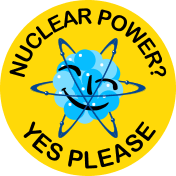While so much is going on in the nuclear world, especially the blogging world, it's hard to pay attention to this, our own nuclear blog. It's hard still to balance technology and political discussions. So, since Left Atomics is on record in support of the use of thorium, I thought I'd repost this great little synopsis of why "Thorium" (Th), specifically the Liquid Fluoride Thorium Reactor is the ideal candidate for the future of humanity's (and in our opinion, socialized, energy system) future energy needs. To REALLY read up on this, go to: energyfromthorium.com and read up on it.
This repost was written by fellow nuclear and LFTR advocate Charles Barton whose father worked at Oak Ridge National Laboratory when these engineers developed the first LFTR prototypes. Charles's web site is Nuclear Green, bookmark it today!
The Benefits of the Liquid Fluoride Thorium Reactor
1. The LFTR is an extremely safe reactor design. It is self regulating. Core meltdown is absolutely not a problem. Continuous removal of radioactive gases insure that only small amounts of radioactive gases would be released in a worst case accident. Coolant leaks do not lead to fires or explosions. There would be little or no solid fission product release/radiation problem in the event of a leak. Because of the chemical properties of the liquid salt coolant/fuel attacks by terrorists using explosives or aircraft, would not create a wide dispersal of radioactive materials. The use of liquid salts eliminating a threat to public safety from terrorists attack on LFTRs.
2. The thorium fuel cycle is efficient. Up to 98% of thorium used in a LFTR can be burned. In contrast only about 0.6% of uranium involved in the LWR/uranium fuel cycle is burned.
3. Virtual elimination f the problem of nuclear waste. The LFTR produces 0.1% of the waste that light water reactors produce, per unit of power produced. Instead, the spent fuel of LFTRs contains many useful and some rare and very valuable metals and minerals. LFTR "spent fuel" represents a potential means of providing industry with rare materials in an increasingly resource starved world.
4. Lowest fuel cycle costs coupled with very high fuel safety. A LFTR is more than a reactor. It is a fuel processing/reprocessing system. The liquid salts approach enables fuel and breeding materials to be processed on a continuous basis while the reactor is producing power. This includes continuous removal of gases produced in the nuclear reaction, the processing of newly breed reactor fuel, the removal of fission products. Nuclear fuel (U-233, U-235, and plutonium) can be continuously added to the reactor. Thus the reactor never needs to stop operating for refueling. The nature of the LFTR fuel cycle makes reactor fuel theft by terrorist impossible, while diversion of reactor fuel for weapons purposes a very unlikely approach to nuclear proliferation.
5. Lower manufacturing, construction and siting costs coupled with great manufacturing time efficiencies. The LFTR can be designed in a size that can be mass produced on assembly lines. Many external parts including heat exchanges can be made from low cost carbon-carbon composite materials, dramatically lowering materials, parts, and assembly costs. High reactor operating temperatures mean that electricity can be generated using low cost-highly efficient closed cycle gas turbines. Compact reactor/generation unit means smaller, less expensive reactor/power unit housing is required. The inherently safer design means that less money needs to be spent on reactor safety systems, and on accident containment, while assuring the highest possible public safety. Small reactor/power generator size can simplify siting problems LRTRs can be manufactured and set up in weeks or months, compared years for custom built LWRs.
6. Liquid core reactors can be used to dispose of existing stocks of nuclear waste..
Thursday, May 1, 2008
Subscribe to:
Comments (Atom)

.png)





